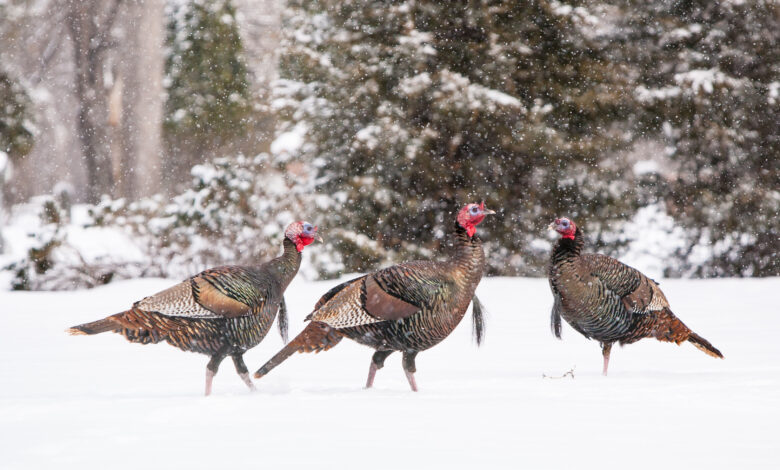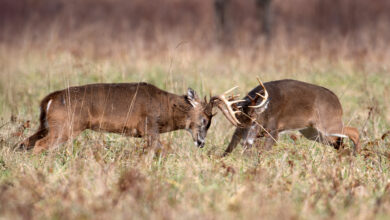The Best Tips For Late Season Turkey Hunting

When you head out for a late season turkey hunting session, one question always remains. Will the gobbler respond to calls, or is it done with gobbling?
Now that’s a puzzle.
Truth is, there is no “yes” or “no” answer to that question. In more than one way, it is both. It all depends on the situation.
If the needle on your patience gauge is close to the red line, things will get tough for you in the late season. Chances are, there are no “easy” turkeys around and you will need to use all the late season turkey tactics you know to punch the tags.
So here are some pro tips for bagging the last-minute tom.
Watch the Weather and Foliage
It is always a good idea to check the weather before you head out for a hunt. Just because it is raining, it does not mean that your hunt is washed out. Once the rain subsides, the turkeys will move out of the roost and move into the open fields. The sound of water dropping from the leaves impacts their hearing, so they prefer to gather in the open.
Make sure to scout out the open fields and food plots in the area before the season starts. This will help you to set up the ambush even if it rains. Be ready to hit a few unconventional spots if needed.
I find tackling heat waves during the late season more challenging. Sitting inside a blind during the mid-day hours when the temperature has touched the peak is a tough task.
Since turkey movement slows down in extreme temperatures, they hardly answer calls during this period. I have found the birds most active when the temperatures are between 60 and 70 degrees Fahrenheit. On a hot day, they tend to be around cool, shaded cover. If there is water around, like a small creek, even better.
The temperatures are comfortable during late evenings and early mornings. This is the best window for turkey hunting during heat waves.
Now, the full foliage in the late season has two impacts. Firstly, obstacles like leaves and branches deflect and absorb the sound waves.
How does that affect the hunt?
With sound traveling less distance, the calls you make will not carry as far as they did in the early season. Likewise, when you hear a gobble, he might be closer to you than you think.
Besides, visibility is reduced in the last part of the season. The panoramic view through leafless trees is no more there. Additionally, shooting through the foliage is tougher.
On the plus side, you can take advantage of the reduced visibility to move closer to the roost site. Moreover, once a longbeard is attracted by your call, he might take longer to spot the decoy through the thick underbrush. For run and gun hunters who do not consider decoys as turkey hunting essentials, this is a great time to increase the success rate.
Note, that late spring is the time when many other outdoor enthusiasts will hit the woods. With reduced visibility, make sure that you always identify the target before shooting.
Call Like You Mean It
In the late season, the birds are past the dominance phase and jealousy factor. But that does not mean they are not looking for a last chance to breed.
By this time Mr. Tom has heard all the turkey calls in the book. So, my late season calling philosophy is “less is more.” Match the calling with the environment and the mood of the birds. Try to make sure that every call you make sounds like a lone hen.
Carrying a variety of the best turkey calls with you is a good idea. If the ol’ tom is not interested in the first hen call you make, try your luck with the other calls.
If you are heading towards a roost, get as close as possible before making the first call. If there is a response, I increase the calling frequency by a notch and wait. If I feel that he is making a positive move in my direction, I continue the calling.
But, things can be different too.
I have seen a few gobblers responding enthusiastically to each soft call that I generated. Interestingly, one longbeard was ready to walk away when I reduced my calling frequency. While such birds are not abundant, they respond to more calling even in this period. The point is, if he is responding positively to your calls, do not hesitate to get aggressive.
Cover More Ground
Not hearing any gobbles?
If you are hunting on grounds with high pressure, the birds can get tight-lipped. That does not mean that the birds are not there. So, stop depending only on calls or use the knowledge you have gathered from scouting. Look out for turkey signs and move to a new location.
Trying a different decoy combination in a new location is a good idea. Many hunters keep wondering if they should leave the decoys behind in this phase. But decoys can still be useful. However, since the aggressive phase is over, you can leave the strutting tom decoys behind.
One of the best turkey decoys you can use in this period is the lone hen. Placing it in a tight cover or a thick cover works best.
Even though the dominance and jealousy phases have mostly ended, you can still take advantage of the turkey’s mentality. I love Art Helin’s suggestion of using the decoys with subtle modifications to target the last bits of the jealousy phase.
In the early part of the season, setting a Jake decoy on top of a breeding hen decoy is a good idea. But in the later phase, it is time to separate the decoys by 5 to 6 yards. Art suggests that this will make the tom think that the hen is unreceptive to the Jake. So, there is a good chance of moving in to make the situation work in his favor.
Plus, this decoy setup is less aggressive which suits the mood of the male birds. As the closing period of the season draws near, you can remove the Jake entirely and depend only on the lone hen decoy.
Hunt During the Day
If you have missed the gobbler during the morning hours, it is time to go after it during the day. Generally, a lone male turkey will be looking for mates between 10:00 a.m. to 2:00 p.m. This is a good time to make the best use of calls and decoys.
Scouting plays a big role in determining the amount of midday action you get. Once you know the noon feeding area, strut zones, and the security cover for the birds, you can pinpoint the right location to set up the ambush.
One good idea will be to add movement to your calls. This gives the impression that a hen is changing location. Keep in mind that the gobblers tend to approach silently during midday. Make sure to keep an eye out so that it does not surprise you with a sudden appearance.
Setup on Ambush Sites
Setting up an ambush site on a travel route or strut zone is not as exciting as following gobbler signs through the woods. But it works as long as you are ready to play the waiting game.
Personally, I love to set up ambush sites near roosting areas. One way is to use the travel corridors and feeding zones around the roosting sites to your advantage. Another of my favorite locations is near dust bowls. These are spots where the birds clean themselves during the midday hours.
Since turkeys move from high to low elevation, pick saddles and occasional flats in hills and mountainsides. If you are stalking open-country turkeys that are feeding, follow an indirect path that leads away from them. That will keep you away from their line of sight.
Woodland trails and old logging roads with food sources around them also attract the birds. Set up your ambush and call sporadically. If the birds move ahead change your location and set up again. Move carefully around the turns in the roads as the gobbler can be standing silently just around the bend.
I keep saying this, but let me repeat once more. Patience is your best friend while ambushing turkeys in late season. Eventually, the birds will make a mistake.
Late Season Turkey Hunting: FAQs
Does it work using turkey decoys in the late season?
Yes, using turkey decoys works in the late season. You need to match your decoys to the mood of the gobblers to make them effective.
How do you call late-season gobblers?
Making soft calling sounds without getting aggressive is the best way to call late season gobblers. Start with sporadic calling and increase the frequency if you get a positive response.
When is the best time of day to hunt turkey in the late season?
For me, mid morning, the period between 7 to 9, has been the most productive time of the day for late spring turkey hunting. Early morning hours before 7 are also good for setting up an ambush.
Final Thoughts
For late season turkey hunting, you are going after birds that have been educated by the early season hunting pressure. So they are more likely to sense anything that is of order.
Fooling these birds is difficult, but not impossible. So, do not let radio silence from the gobblers bring down your motivation. The fact is, many pro gunters prefer the late season when the hunting pressure is low and the gobblers are still eager to find a non-bred hen.
Even though the conditions in the late season are different from the early season turkey hunting challenges, the basics remain the same. All you need to do is make the necessary tweaks to match your strategies with the late-season transitions.



